Overview
The article outlines nine key benefits of investing in real estate storage units, emphasizing their potential for reliable cash flow, low operating costs, and resilience during economic downturns. These advantages are supported by trends indicating strong demand for storage solutions driven by:
- Urbanization
- Flexible leasing options
- The ability to diversify investment portfolios
This makes storage units a strategic choice for investors looking to enhance their asset allocation and capitalize on emerging market opportunities.
Introduction
In the rapidly evolving landscape of real estate investment, self-storage facilities have emerged as a beacon of opportunity. Investors are increasingly drawn to this sector, not only for its potential to generate reliable cash flow but also for its resilience during economic downturns.
With urbanization driving demand and innovative leasing options catering to diverse tenant needs, self-storage presents a unique chance for portfolio diversification and long-term value growth.
As industry analysts provide insights into market trends and consumer behavior, the self-storage market stands poised for substantial growth. This makes it an attractive prospect for savvy investors looking to capitalize on this burgeoning field.
Zero Flux: Daily Insights on Real Estate Storage Investment Benefits
Zero Flux delivers essential daily insights for those eager to enter the storage sector. By meticulously curating data from over 100 diverse sources, it offers a comprehensive analysis of industry trends, empowering investors to make informed decisions. In a sector as dynamic as personal storage, where consumer behaviors shift due to factors like relocation and downsizing, timely information is vital for optimizing investment strategies.
The storage market increasingly emphasizes customer convenience and innovative storage solutions. Industry analysts note that the evolving landscape presents significant opportunities for investors. For example, operators can cater to a wide range of demographics, including young professionals and Baby Boomers, by providing tailored storage options that address their unique needs for space and security.
Recent trends indicate a rising demand for storage facilities, driven by lifestyle changes and urbanization. This trend is further supported by industry developments, such as Streams Development's invitation for landowners with zoned properties to participate in the expanding self-storage market. Such initiatives highlight the sector's potential for expansion and profitability, directly influencing funding strategies by encouraging investors to consider areas with high demand.
With more than 25 analysts providing insights, Zero Flux ensures subscribers receive accurate and practical information, essential for navigating the complexities of real estate storage units. Aditi Shivarkar, Principal Consultant, emphasizes that "accurate, actionable insights drive excellence in industry trends and sustainability," reinforcing the value of the information provided. Additionally, a recent case study titled 'Self-Storage Industry: Opportunities on the Horizon' reveals that operators can effectively cater to diverse consumer groups by offering tailored storage solutions, further underscoring the investment potential in this developing sector. This commitment to data integrity and clarity establishes Zero Flux as a leading authority in real estate information, making it an indispensable resource for individuals aiming to capitalize on the promising future of the storage market.
Steady Income: Reliable Cash Flow from Storage Units
Investing in real estate storage units provides a compelling opportunity for generating reliable cash flow, largely due to their consistently high occupancy rates. As we look toward 2025, the average occupancy rate for real estate storage units is projected to remain robust, underscoring the sector's resilience and ongoing demand. Flexible leasing options, such as month-to-month agreements, empower tenants to adjust their storage needs, thereby ensuring a steady income stream for investors. This adaptability enables property owners to adjust rental rates in response to economic fluctuations, further enhancing profitability.
Financial specialists project that the storage industry will achieve a valuation of $72.15 billion by 2028, emphasizing its potential for lucrative returns. Furthermore, the real estate storage units market is expected to expand at a compound annual growth rate (CAGR) of 5.76% over the next five years, driven by emerging trends like virtual tours and online reservations that elevate the customer experience and contribute to higher occupancy rates. Case studies, such as the 'Self-Storage Market Outlook,' illustrate successful cash flow examples from real estate storage unit ventures, demonstrating how strategic management of occupancy rates can significantly impact profitability.
Investors who leverage these insights can capitalize on the evolving landscape of real estate storage units, making them a strategic addition to their real estate portfolios. As Maggie Stankiewicz notes, understanding these dynamics is crucial for making informed decisions in this burgeoning sector.
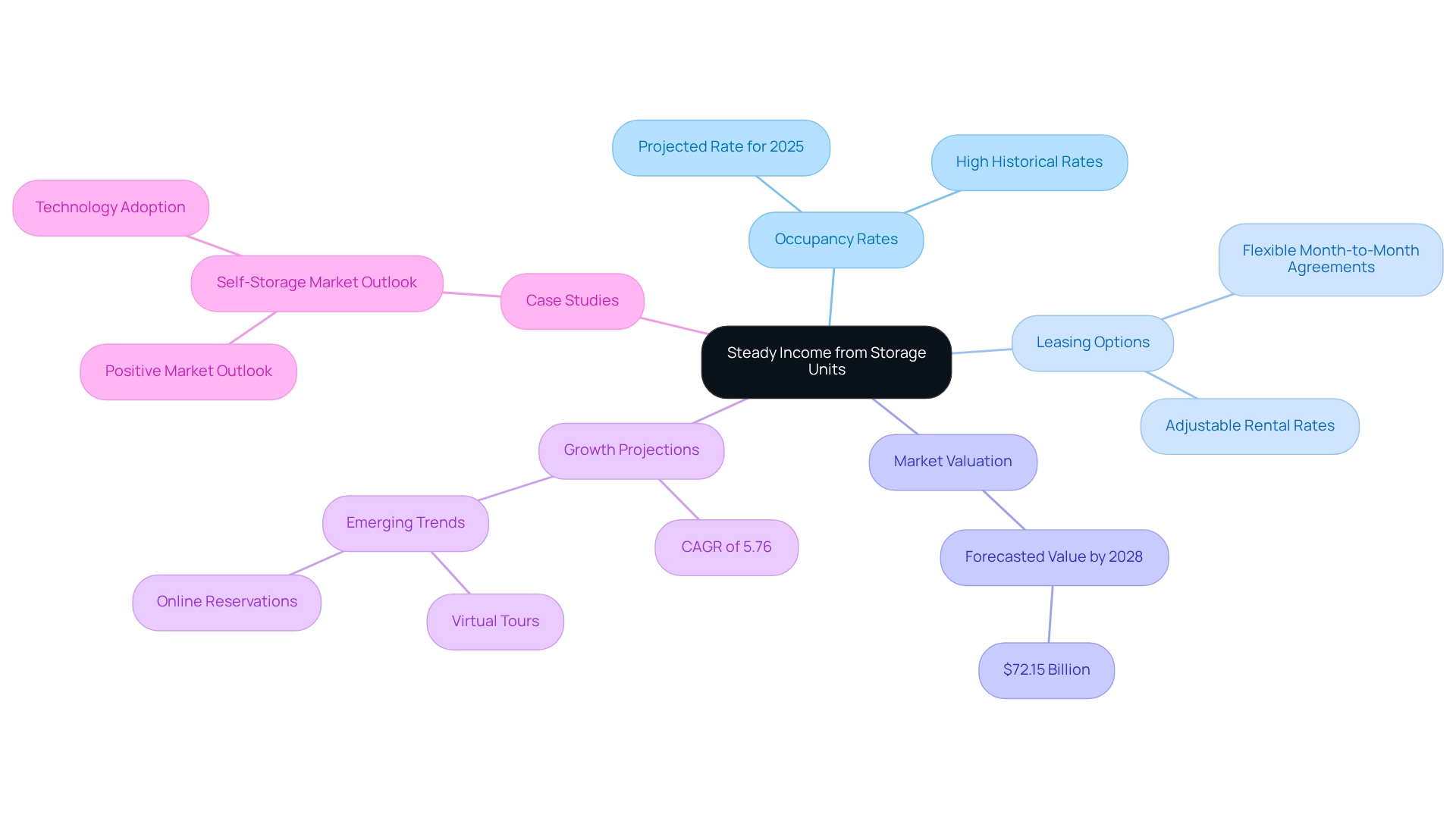
Recession Resistance: Stability During Economic Downturns
Self-storage facilities have demonstrated remarkable resilience during economic downturns. Historical data indicates that storage asset contributions yielded a favorable 5% return during the Great Recession of 2008, underscoring their reliability in challenging times. As individuals and businesses often downsize or face financial hardships, the demand for real estate storage units typically rises, positioning personal storage as a dependable choice that offers protection against economic fluctuations.
Experts highlight that real estate storage units feature relatively simple building designs with lower maintenance requirements compared to other commercial properties, making them an attractive option for those seeking recession-resistant investments. Recent trends reveal that 88% of U.S. metro areas experienced population growth between 2023 and 2024, directly impacting the demand for additional storage space. This demographic growth further fuels the need for real estate storage units, establishing them as a strategic asset for investors aiming to navigate market uncertainties.
Class A real estate storage units, known for their high quality and prime locations, generally incur lower maintenance costs than other real estate investments. These facilities tend to be newer or well-maintained, leading to reduced operating expenses due to lower utility needs and infrequent repairs. The demand for storage options remains robust, even during economic downturns, reinforcing the argument for personal storage as a strategic asset.
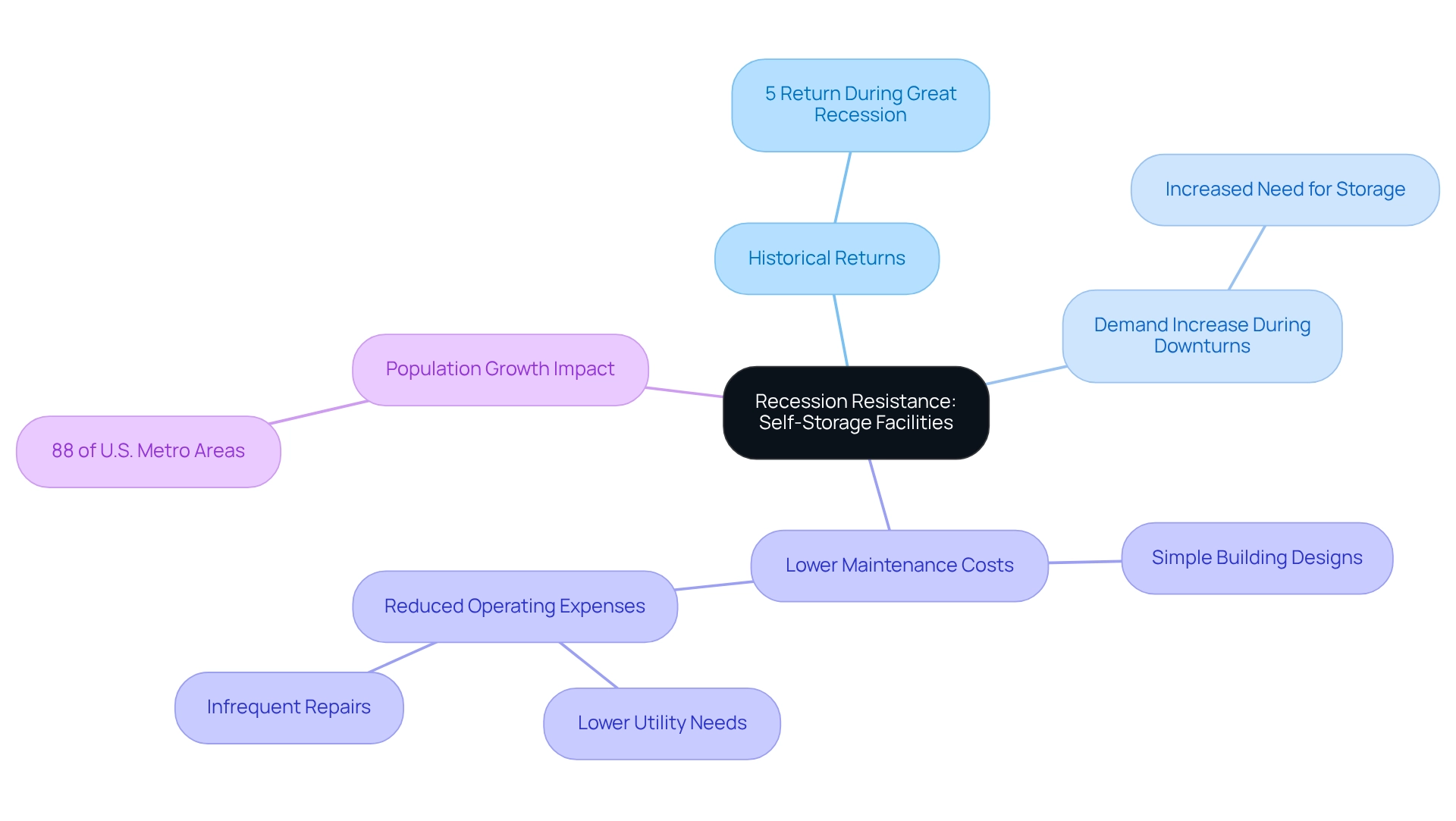
Low Operating Costs: Maximizing Profitability in Storage Investments
A notable benefit of personal storage investments lies in their exceptionally low operating expenses. Unlike residential properties, which often demand extensive maintenance and management, storage units require minimal upkeep. This operational efficiency enables stakeholders to significantly enhance their profit margins, as a larger portion of rental income is retained as profit. In fact, storage facilities are frequently regarded as recession-proof due to their diverse tenant demographic and adaptable rental agreements, which help maintain steady cash flow even during economic downturns. This resilience is particularly appealing for investors looking to mitigate risks in unpredictable economic climates.
Recent insights reveal that storage facilities incur lower turnover expenses, as substantial renovations or refurbishments are generally unnecessary between occupants. This allows for quicker unit readiness, further optimizing revenue potential. A survey conducted by SpareFoot, LLC in February 2025, involving 1,006 adults, highlighted consumer preferences in the storage sector, reinforcing the demand for these facilities. Key findings from the survey indicate that a significant percentage of respondents favor personal storage options for their flexibility and affordability, underscoring the expanding market for these investments. Moreover, industry experts stress the importance of comprehending operating costs to maximize profitability. As Frank Gallinelli, an Ivy-League professor and founder of RealData Software, notes, developing the skills to evaluate property opportunities is crucial for achieving maximum profit. Furthermore, Jeremiah Boucher's success in generating substantial returns in just 7 years stands as a testament to the potential profitability of personal storage assets. By focusing on the low operating expenses of real estate storage units and contrasting them with residential properties, individuals can strategically position themselves to capitalize on this lucrative segment of the real estate market.
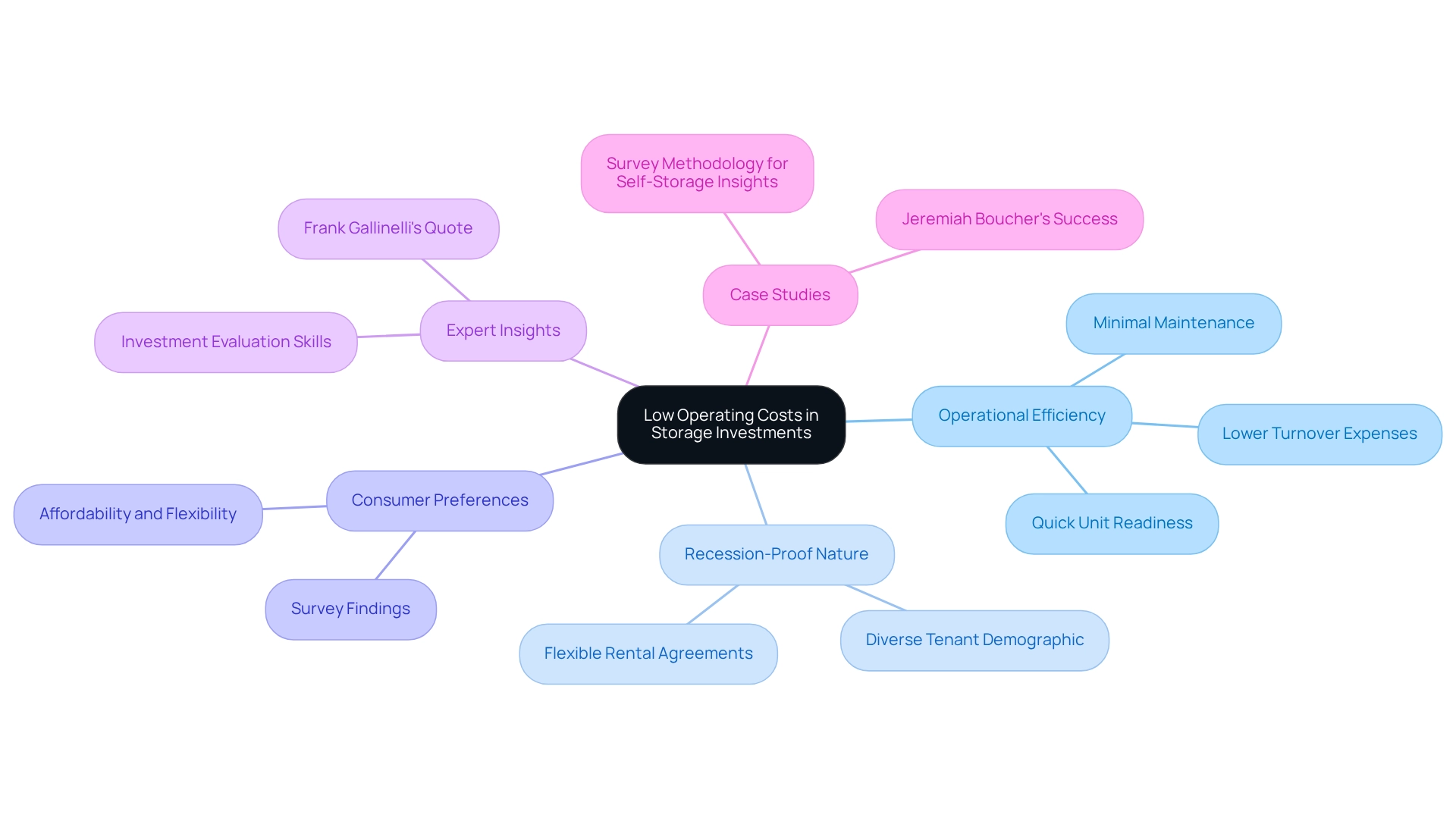
Minimal Management: Simplified Operations for Investors
Self-storage facilities are increasingly recognized for their low management demands compared to traditional real estate storage units. The integration of automated systems for billing and access control enables stakeholders to efficiently manage these properties with minimal oversight. This operational simplicity not only reduces the burden of daily management but also allows investors to concentrate on expanding their portfolios. As Jack Colemanzo, Head of Sales, mentions, "There are currently over 50,000 storage facilities in the US," emphasizing the vast potential in the industry.
The storage industry has witnessed a notable 7 percent yearly job growth from 2017 to 2022, suggesting a strong market that fosters automation and efficiency. Furthermore, the average rental rate for a 10-by-20 non-climate-controlled unit stands at $172.76, showcasing the profitability potential of these investments. As the industry embraces advanced technologies, including mobile apps and AI for predictive analytics, the operational landscape is evolving.
These innovations not only enhance service delivery but also improve customer experiences and streamline operations, making real estate storage units an appealing choice for those seeking simplified management solutions. Investors can leverage these automated systems in their own facilities to maximize efficiency and profitability, reinforcing the viability of minimal management in this sector.
Growing Demand: Capitalizing on Urbanization Trends
The ongoing trend of urbanization is significantly increasing the demand for real estate storage units. As more individuals and businesses migrate to urban centers, the prevalence of smaller living spaces has surged, creating a pressing need for real estate storage units as additional storage options. This shift presents a lucrative opportunity for investors to strategically position real estate storage units in high-demand urban locales, where the influx of tenants is virtually guaranteed.
Case studies underscore the resilience of the storage industry, particularly in urban areas facing escalating rental costs. For example, the case study titled 'Market Opportunities in Storage Solutions' illustrates how North Carolina has seen a marked increase in demand for storage options, as both businesses and residents seek economical ways to manage their belongings. This trend underscores the potential for substantial returns on investment in storage facilities, especially in densely populated regions.
Urban development specialists emphasize that the impact of city living on storage needs is significant, with many advocating for the expansion of real estate storage units to meet this growing demand. Investors aiming to capitalize on this trend should consider reaching out to Streams Development if they possess land designated for self-storage opportunities. By harnessing these urbanization trends, stakeholders can not only enhance their portfolios but also provide essential services that cater to the evolving needs of city residents.
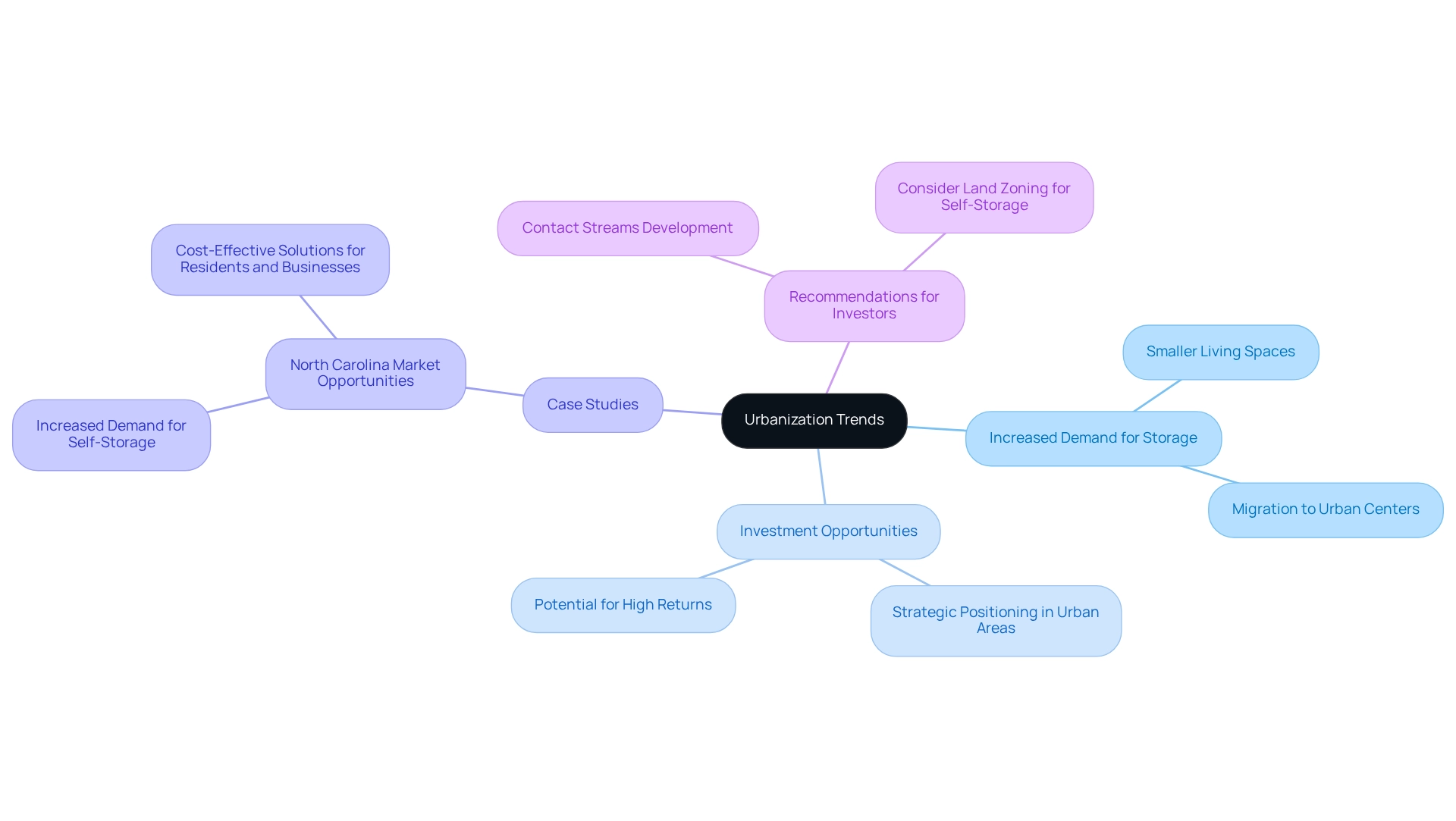
Flexible Leasing: Adapting to Market and Tenant Needs
Self-storage facilities are increasingly offering flexible leasing options, particularly month-to-month agreements, which cater to diverse tenant needs. This flexibility not only broadens the customer base but also allows investors to swiftly adapt to economic fluctuations. Industry analysts emphasize that such flexibility is vital, aligning with tenant preferences for short-term commitments, especially among boat owners and those seeking temporary storage solutions. Yardi Matrix notes that the low penetration of existing stock often attracts storage developers, highlighting the potential for flexible leasing options. While the average monthly cost for a standard 10x30 feet storage unit hovers around $300, the ability to rent on a month-to-month basis can justify higher rates due to the convenience and flexibility provided.
Case studies illustrate that successful storage facilities frequently implement adaptable leasing strategies, enabling them to maintain high occupancy rates and maximize revenue. For example, facilities that modify lease terms in response to seasonal demand or local market trends have shown improved financial performance. Insights from the case study titled "Cost Comparison of Temporary Storage" reveal that while temporary storage units may carry a higher price tag than long-term options, they offer flexibility that justifies the elevated monthly rates for short-term needs. As technology continues to influence the storage sector, the integration of mobile applications and automated kiosks enhances the tenant experience by streamlining the leasing process and providing improved accessibility. This combination of flexible leasing and technological advancements positions storage solutions as a compelling investment opportunity in 2025.
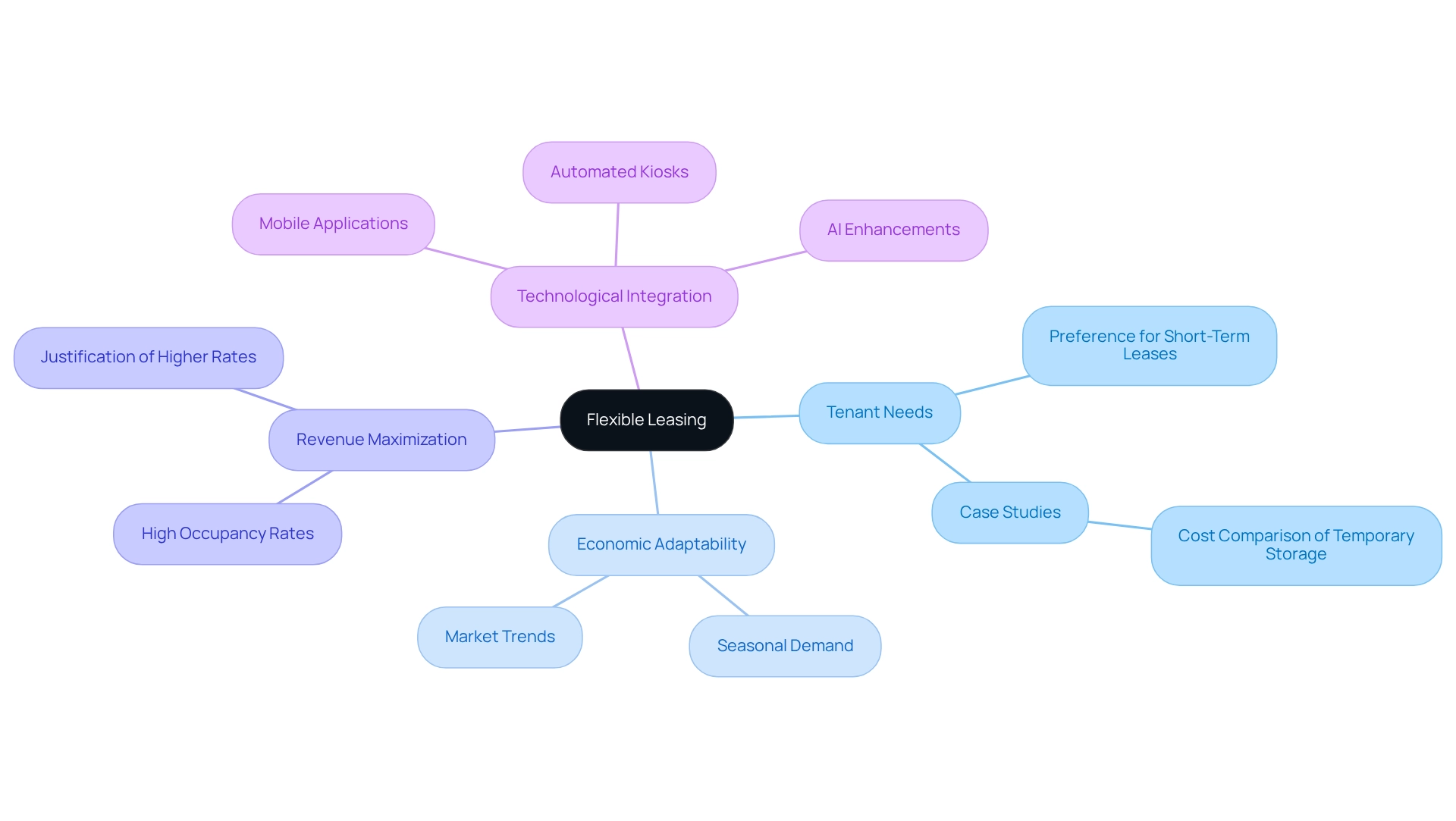
Property Appreciation: Long-Term Value Growth in Storage Units
Investing in real estate storage units not only generates immediate cash flow but also offers significant long-term appreciation potential. The storage industry is witnessing a remarkable surge, with rental rates reaching unprecedented heights and projections indicating sustained growth. The global self-storage market is anticipated to expand from $64.14 billion in 2023 to $85.27 billion by 2030, propelled by the increasing demand for additional space. This trend underscores the substantial returns available for individuals entering this sector.
As demand for real estate storage units escalates, existing properties are well-positioned for considerable value growth. Notably, millennials are emerging as the primary renters of outdoor space, providing a unique opportunity for stakeholders to target this demographic. Furthermore, expert opinions emphasize that the adaptability of storage facilities allows businesses to tailor their storage needs according to demand, enhancing their appeal. As noted by Grand View Research, "businesses benefit from the flexibility to scale their storage space up or down based on demand."
Data indicates that nearly 90% of individuals utilizing storage facilities are men, highlighting a specific market segment that stakeholders can leverage. By tailoring marketing strategies to resonate with this demographic, stakeholders can enhance their engagement and occupancy rates. The convergence of these factors positions real estate storage units as a compelling investment avenue, with long-term appreciation rates expected to remain favorable. By focusing on data-driven insights and market trends, stakeholders can adeptly navigate the storage sector and capitalize on its growth potential.
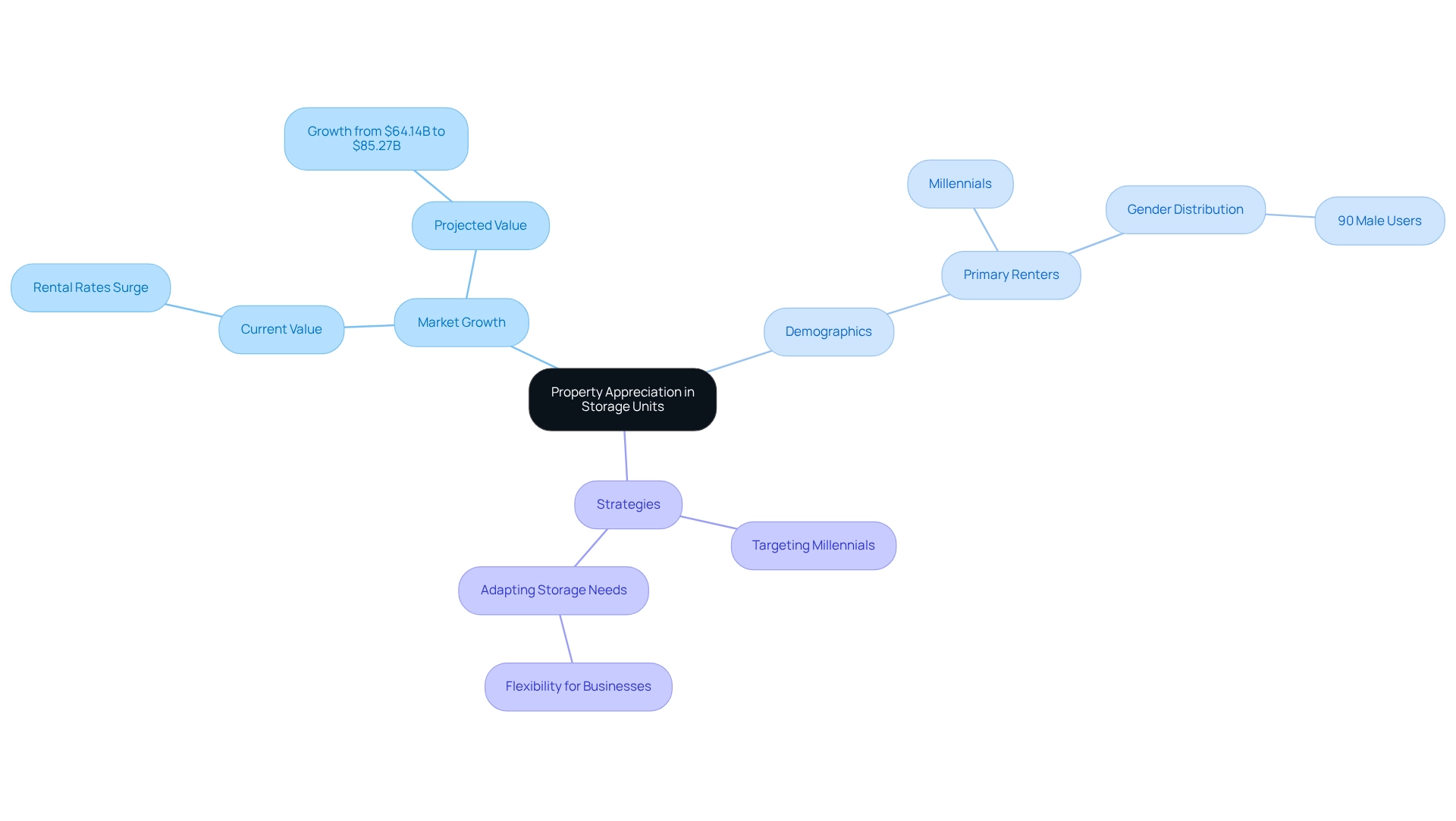
Portfolio Diversification: Reducing Risk with Storage Investments
Investing in storage facilities presents a compelling opportunity for portfolio diversification. By incorporating real estate storage units into their financial strategies, individuals can effectively reduce overall risk, as these self-storage assets frequently demonstrate unique performance trends compared to conventional real estate holdings. This distinct behavior contributes to more stable returns and reduced volatility within an investor's portfolio.
Expert opinions underscore the significance of diversification in financial strategies. As strategist Mark LaMonica aptly states, "Avoid diversification at your peril." This sentiment resonates particularly in the context of personal storage, where the asset class has shown resilience even during economic downturns. For instance, Reliant's average hold time for properties is slightly more than three years, suggesting a stable financial horizon that can shield against market fluctuations and enhance a more secure financial profile.
The advantages of storage investments extend beyond mere risk mitigation; they can also enhance overall portfolio performance. With rental prices expected to continue rising due to ongoing demand, real estate storage units serve as a dependable source of income. Furthermore, lessons learned from the Global Financial Crisis highlight the risks associated with concentrated positions in traditional assets. Investors who embraced real estate storage units during that period often found themselves better positioned to weather economic storms, as diversification into real estate storage units provided a buffer against the volatility of other asset classes.
In 2025, the landscape for personal storage opportunities is evolving, with technology playing a more crucial role. Businesses are adopting advanced technologies, such as automated management systems and customer service platforms, to improve operational efficiency and enhance the customer experience. These innovations not only streamline processes but also attract a wider clientele, further boosting the appeal of storage solutions as a viable financial opportunity. By including real estate storage units in their portfolios, stakeholders not only mitigate risk but also capitalize on a burgeoning sector that offers stability and opportunities for expansion. To effectively integrate self-storage investments, investors should conduct thorough market research, evaluate local demand, and explore partnerships with established self-storage operators.
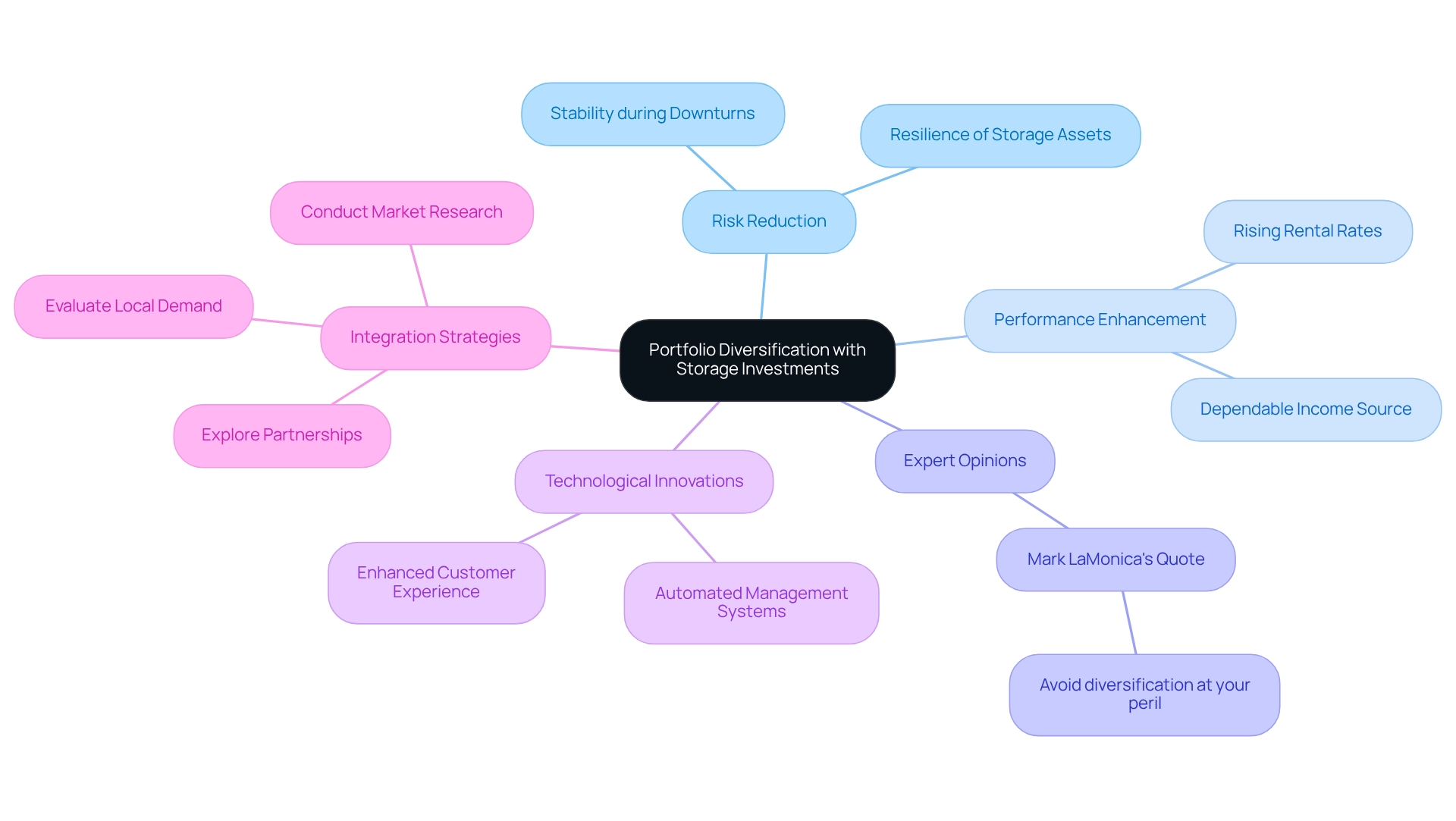
Conclusion
The self-storage investment sector offers a wealth of opportunities, propelled by trends such as urbanization, flexible leasing options, and a growing demand for additional space. Insights from industry experts reveal that self-storage facilities not only provide reliable cash flow but also exhibit resilience during economic downturns. This sector is marked by low operating costs and minimal management demands, making it an appealing choice for both novice and seasoned investors.
With market projections indicating significant growth—valued at $64.14 billion and expected to rise to $85.27 billion by 2030—the potential for long-term appreciation is considerable. The versatility of self-storage facilities enables them to meet diverse tenant needs, further enhancing their attractiveness. Moreover, integrating self-storage into investment portfolios can be a strategic approach to diversify risk and stabilize returns amid economic uncertainties.
Ultimately, investing in self-storage transcends immediate cash flow; it is about positioning oneself within a burgeoning market that promises both stability and growth. By leveraging current market trends and consumer behaviors, investors can seize the unique advantages offered by self-storage facilities, making it a compelling addition to any real estate portfolio. As the self-storage landscape continues to evolve, embracing these opportunities can lead to significant financial rewards.




